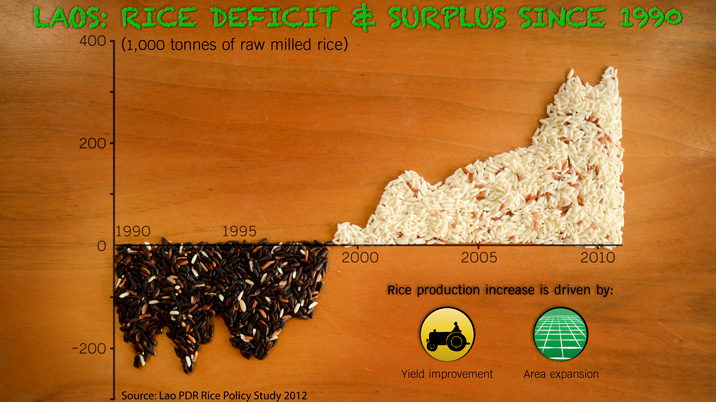The World Bank, Food and Agriculture Organization, and International Rice Research Institute produced the Lao PDR: Rice Policy 2012 report. This study is a first attempt to analyze rice sector in Lao PDR, also commonly known as Laos, through an in-depth analysis which combines technical aspects of rice production with a broad-based socio-economic analysis. The Lao government commissioned the report.
Key Findings
- Lao rice production has been increasing significantly since the early 1990s. It was driven by area expansion and increase in yields. Rice production in Laos has more than doubled over 1991–2011, and reached around 3.3 million tons of paddy in 2011.
- While Laos has still one of the highest per capita annual rice consumption levels in the world, there is evidence that it had reached the peak in mid-2000s and is now on a declining trend.
- A significant portion of the population of Laos is already located past the maximum rice per capita consumption level and this trend has become more pronounced between 2002/03 to 2007/08.These trends, when combined with declining population growth and increasing urbanization, have led to increasing and stable rice surpluses in the country.
- Today, Laos has achieved rice self-sufficiency at the national level. At the regional level, there are differences in rice self-sufficiency among the provinces, with the major rice deficit areas being in the north. However, rice insufficiency does not necessarily mean food insecurity as farmers are increasingly diversifying into export crop production.
- Laos would continue to build exportable surpluses of rice even when assuming modest production growth and conservative demographic changes. The exportable surplus is expected to reach 0.45–0.5 million tons by 2015 from the current 0.3 million tons.
- Increasing surpluses have not translated into increasing income of farm households, due to suppressed farm gate prices (the price of the product at which it is sold by the farm) of paddy and increasing production costs.
- Analysis suggests that low input/low output rice farming households (which is the majority of farm households) are unable to obtain sufficiently high incomes from rice production.
- Farmers are moving increasingly out of rice production. The proportion of rice-growing households has decreased from 77 percent of all households in 1998/99 to 71 percent in 2010/11.
- Rice production is becoming increasingly concentrated in few regions with natural comparative advantages.
Challenges
- Despite increasing surpluses and suppressing farm gate prices, the government is restricting formal and informal exports of paddy and rice.
- The rice milling sector is underdeveloped and inefficient, which makes it difficult for its milled rice to compete in regional and international markets.
- As the Lao rice sector has moved from deficit to surplus production and is going through a profound transformation, both at the consumption and production levels, the current policy mix may no longer be optimal for achieving the government objectives of food security and economic growth.
- Significant trade and public spending policy changes are needed if the Government wants to achieve its rice production and export targets.
Options for improving rice policies
- Facilitate trade. To be more competitive, eliminate export bans and create a more transparent export environment for rice and paddy. There is interest from Thailand, China, and Vietnam in importing cheaper Lao paddy, which could be milled in their countries and sold on domestic or international markets.
- Improve the efficiency of the rice milling sector. The Laos rice milling sector is currently not able to absorb all surplus paddy production. The main constraint for export of Laos milled rice is its high cost relative to quality. Overcoming milling constraints would require significant private investments (from domestic or foreign sources) into large modern mills and polishing factories.
- Improve the efficiency and impact of public funds for agriculture. There should be more balanced approach in allocating resources to technology development, extension and irrigation. Funds should also go to high impact activities, such as seed production and breeding new quality rice lines.
- Public investment programs should be targeted to geographical areas with the highest production potential and where farmers can achieve the largest gains.
- Improve knowledge on data on food security and agriculture to better inform the policy decisions.
